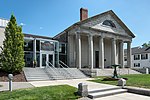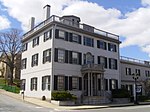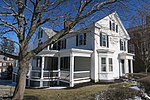National Monument to the Forefathers
1888 sculptures1889 establishments in MassachusettsBuildings and structures in Plymouth, MassachusettsGranite sculptures in MassachusettsHistory of the Thirteen Colonies ... and 7 more
Marble sculptures in MassachusettsMonuments and memorials in MassachusettsMonuments and memorials on the National Register of Historic Places in MassachusettsMonuments and memorials to the PilgrimsNational Register of Historic Places in Plymouth County, MassachusettsSculptures of booksTourist attractions in Plymouth County, Massachusetts

The National Monument to the Forefathers, formerly known as the Pilgrim Monument, commemorates the Mayflower Pilgrims. Dedicated on August 1, 1889, it honors their ideals as later generally embraced by the United States. It is thought to be the world's largest solid granite monument.
Excerpt from the Wikipedia article National Monument to the Forefathers (License: CC BY-SA 3.0, Authors, Images).National Monument to the Forefathers
Plymouth
Geographical coordinates (GPS) Address Nearby Places Show on map
Geographical coordinates (GPS)
| Latitude | Longitude |
|---|---|
| N 41.96 ° | E -70.676111111111 ° |
Address
Plymouth
Massachusetts, United States
Open on Google Maps










